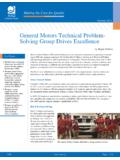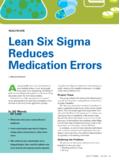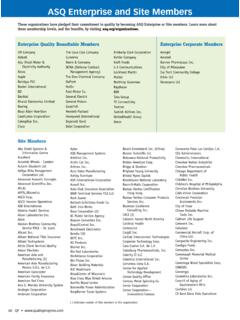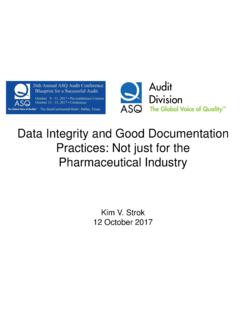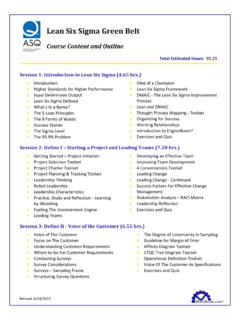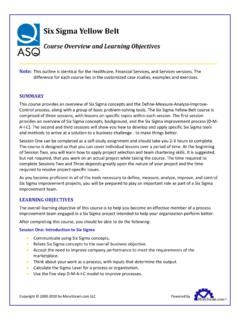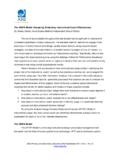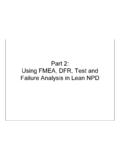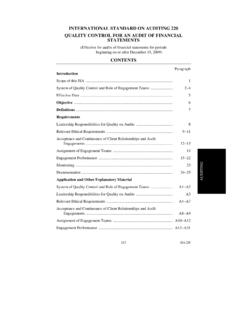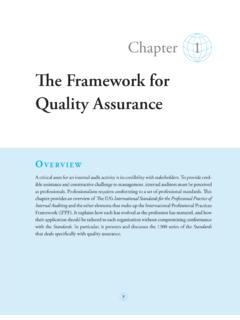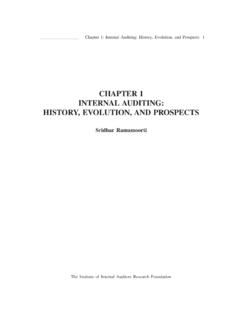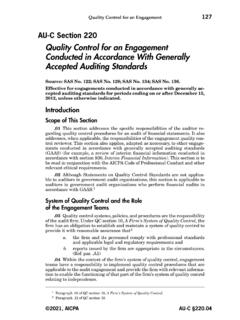Transcription of Auditing Process-based Quality Management Systems
1 Auditing Process-based Quality Management Systems Charlie Cianfrani and Jack West C. A. Cianfrani & J. E. West January, 2013 C. A. Cianfrani & J. E. West January, 2013 Agenda Course objectives What is an audit? How to prepare for and plan an audit How to conduct an audit How to report on an audit Course closing C. A. Cianfrani & J. E. West January, 2013 C. A. Cianfrani & J. E. West January, 2013 Course Objectives Learn the basics of performing internal audits of a QMS based on the process approach process mentality Consider policy, objectives, processes, products and organizational alignment Prepare an audit plan Conduct an audit Document findings Write an audit report Ensure follow-up on corrective actions C.
2 A. Cianfrani & J. E. West January, 2013 C. A. Cianfrani & J. E. West January, 2013 Agenda Course objectives Introductions What is an audit? How to prepare for and plan an audit How to conduct an audit How to report on an audit Course closing C. A. Cianfrani & J. E. West January, 2013 C. A. Cianfrani & J. E. West January, 2013 What is an audit? An audit* is a systematic, independent and documented process for obtaining audit evidence and evaluating it objectively to determine the extent to which audit criteria are fulfilled * Definition is from both ISO 9000:2005 Quality Management Systems - Fundamentals and vocabulary ISO 19011:2011 Guidelines for Quality and/or environmental Management Systems Auditing C.
3 A. Cianfrani & J. E. West January, 2013 C. A. Cianfrani & J. E. West January, 2013 What is an internal audit? An internal Quality audit is an audit that is performed by or at the direction of members of the organization C. A. Cianfrani & J. E. West January, 2013 C. A. Cianfrani & J. E. West January, 2013 Why audit? Possible reasons to audit: ensure compliance with ISO 9001:2008 ensure compliance with organization requirements ensure compliance with regulatory requirements ensure the QMS is effectively implemented and maintained C. A. Cianfrani & J. E. West January, 2013 C. A. Cianfrani & J. E. West January, 2013 Why audit?
4 (continued) Auditing for improved performance look for opportunities for improvement look for best practices that could be applied in other areas look for preventive action look for outstanding emphasis on customer satisfaction C. A. Cianfrani & J. E. West January, 2013 C. A. Cianfrani & J. E. West January, 2013 Principles of Auditing Ethical conduct Fair presentation Professional care Independence Objectivity Impartiality Evaluations based on evidence Competence Cooperation Trust C. A. Cianfrani & J. E. West January, 2013 C. A. Cianfrani & J. E. West January, 2013 Audit vs. Management Review vs.
5 Self-assessment Three complementary concepts: What do we mean by self-assessment? - ISO 9004:2009 Annex A - Baldrige What do we mean by Management review? They are all approaches to ensuring effectiveness, efficiency, improvement and customer satisfaction C. A. Cianfrani & J. E. West January, 2013 C. A. Cianfrani & J. E. West January, 2013 Three Types of Audits External independent audits third party Customer audits of suppliers second party Internal audits first party C. A. Cianfrani & J. E. West January, 2013 External independent audits third party Conformity to a specific standard ORGANIZATION CUSTOMER REGISTRAR LIST STANDARD (9001) Three Types of Audits C.
6 A. Cianfrani & J. E. West January, 2013 Customer audits of suppliers second party Conformance to customer requirements Customer s special interest items STANDARD ( ISO 9001) OTHER REQUIREMENTS ORGANIZATION CUSTOMER Three Types of Audits C. A. Cianfrani & J. E. West January, 2013 Internal audits first party Performance to the organization s objectives Identification of problem areas! Finding opportunities for improvement! Three Types of Audits C. A. Cianfrani & J. E. West January, 2013 The process Approach Evolving nature of Quality Management Internal focus vs. customer focus Control vs. improvement QA by QA vs.
7 QA by organization Leadership: from QA or from Management Documented procedures vs. manage processes Independence of QA vs. integration Alignment of business, policy and objectives C. A. Cianfrani & J. E. West January, 2013 Remember the Quality Management principles? Principle #4 process Approach A desired result is achieved more efficiently when activities and related resources are managed as a process . Principle #5 system approach to Management Identifying, understanding, and managing interrelated processes as a system contributes to the organization's effectiveness and efficiency in achieving its objectives C.
8 A. Cianfrani & J. E. West January, 2013 process Output Input Activity Activity Activity process Controls Resources A group of interrelated activities and related resources that transforms inputs into outputs C. A. Cianfrani & J. E. West January, 2013 Driven by Top Management C U S T O M E R Focused on process process process process process Network of Interrelated Processes Continually Improving Effectiveness system : A Family of Well Managed Processes C. A. Cianfrani & J. E. West January, 2013 The SIPOC Model of a process Suppliers process Customers Outputs Inputs Requirements & Feedback The SIPOC model (suppliers, inputs, processes, outputs, customers) shows linkage of: processes from suppliers to final customers feedback from customers to the organization feedback from the organization to suppliers (see pg 16 in audit book) Requirements & Feedback Suppliers process Customers Suppliers process Outputs Customers Suppliers process Inputs Outputs Customers Suppliers process C.
9 A. Cianfrani & J. E. West January, 2013 ISO 9001 and Auditing Audits are covered in clause of ISO 9001:2008 which is part of section 8 Measurement, analysis and improvement Emphasizes determining effective implementation and maintenance of the Quality Management system Note: the overall effectiveness of the Quality Management system is the responsibility of top Management C. A. Cianfrani & J. E. West January, 2013 Agenda Introductions Course objectives What is an audit? How to prepare for and plan audits How to conduct an audit How to report on an audit Course closing C. A. Cianfrani & J.
10 E. West January, 2013 Planning the Audit Program C. A. Cianfrani & J. E. West January, 2013 The Audit process An Overview Internal audit Management Provide resources Review results Use results Internal audit Internal audit Policy History Documents Customer feedback Planning Input Output Audit Report Findings/CARs Follow-up Improvement Conclusions Information Time Trained personnel Resources C. A. Cianfrani & J. E. West January, 2013 Audit Conclusions Audit output conclusions may include: Conclusion regarding the conformance of the audited process to ISO requirements Statements regarding the suitability of a process to achieve objectives Comments regarding the effective implementation of a process Suggestions for consideration regarding possibilities for improvement C.
